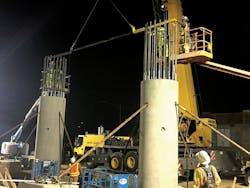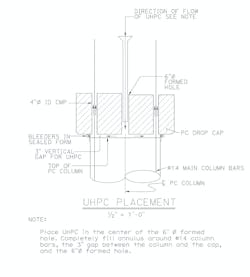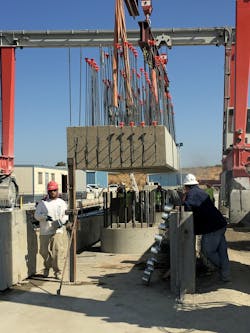Seismic effect
The Laurel Street Overcrossing (OC) is the first in a series of multi-span accelerated bridge construction (ABC) pilot projects that the California Department of Transportation (Caltrans) is building to assist in the mainstreaming of ABC into its project delivery system.
Due to the demands that earthquakes place on California’s bridges, particular attention must be paid to the performance of ABC structures under seismic loading. In the case of multi-span precast structures, the focus is on connections. Caltrans has invested over $5 million in research to support the development of seismic design practices that will provide robust performance of joints connecting precast elements under everyday (service-level) demands as well as a 1,000-year seismic event. ABC connection details result from a multi-step seismic research deployment sequence that begins with research concepts and ends with standardized design policy. The Caltrans Earthquake Committee evaluates the research after it has been completed and the details that perform well in a laboratory environment are incorporated into pilot projects for real-world application. It is one thing to build a test specimen under the controlled conditions of a university lab, but quite another to build a bridge at a jobsite in a low-bid environment.
Pilot projects are a key step in moving from the theoretical to the practical. Caltrans examines what works well and what needs improvement by focusing on performance, reliability and constructability issues. Information collected during the pilot projects is used to develop standardized guidance and design details to provide improved efficiencies and reduce the risks typically associated with new construction methods. These projects are not built under the pressure of an accelerated schedule. Time will be provided for thoughtful planning, review and continual improvement. After the methods have been standardized, subsequent projects will be built quickly resulting in significant savings in the number of on-site construction days and construction-related impacts.
The Laurel Street OC is located about 30 miles northeast of San Francisco over I-780 in the city of Vallejo. The existing 60-year-old structure had a history of high load hits and had been repaired numerous times. The replacement design provides increased vertical clearance, improved sight distance, and a wider cross section to accommodate shoulders and sidewalks. The new 200-ft-long bridge has two spans of approximately 100 ft supported on seat-type abutments and a two-column bent founded on spread footings. The Laurel Street OC replacement project was identified as an excellent candidate for Caltrans’ first multi-span precast ABC pilot due to its location, bridge geometry and the particular advantage of having an innovative project delivery team. The precast structural elements include solid circular columns, a rectangular drop cap and wide flange girders. The precast column, cap, and girder connections are based on Caltrans funded research performed at the University of Nevada, Reno, (UNR) and Iowa State University (ISU). In addition to piloting precast construction, a four-hour rapid strength concrete (RSC) cast-in-place (CIP) deck was incorporated into the ABC design.
The Laurel Street OC was designed by Caltrans Bridge Engineer Isaias Yalan and built by RNR Construction Inc. of Sacramento, Calif. The construction contract was awarded through the design-bid-build/low-bidder procurement method.
The fabricator demonstrated through the use of templates that the short substitute columns and the bridge columns had the same rebar layout.
Connections
The column-to-cap connection detail developed for this project is based on UNR’s research “Next Generation of Bridge Columns for ABC in High Seismic Zones.” The research project investigated eight connection types with varying outcomes. Upon review by the Caltrans Earthquake Committee, the ultra-high performance concrete (UHPC)-filled duct connection was selected as the preferred alternative due to performance, simplicity and reliability. The full-scale implementation of this connection consisted of a circular pattern of 20 No. 14 reinforcing bars extending from each column threaded through a precast drop cap via multiple 4-in. internal diameter corrugated galvanized metal ducts. The ducts and a 3-in. void between the column and cap were filled with Ductal JS1000, a proprietary mix of UHPC supplied by LafargeHolcim. Caltrans engineers worked closely with representatives of the Precast Concrete Institute (PCI) and the UHPC supplier to develop a placement strategy that would be simple to execute and provide uniform distribution of the UHPC material.
The girder-to-cap detailing was derived from concepts developed at Caltrans, the Washington State Department of Transportation and ISU, then tested under the “Seismic Performance of Precast Girder-to-Cap for ABC of Integral Bents” research conducted at ISU. This research considered six different connection details to establish girder continuity at the bent. Four of the connections were targeted for inverted “T” bent caps, and two of the connections focused on a drop bent cap configuration. All of the connections performed well and were evaluated for cost and constructability. For the purpose of this pilot project the extended unstressed strand detail was selected, as it was perceived to be the least expensive and easiest to build. This detail establishes continuity by using existing pre-stressing strands in the precast girder. Strands that are typically burned off at the end were extended out of the girder to overlap with strands from the opposing girder in the cast-in-place diaphragm above the precast cap. An important detail of this connection is a specified minimum radius of strand bend to avoid overstraining the steel.
Plans and specifications
The plans and specifications contained details and provisions that were incorporated to specifically support the success of the ABC design. The bridge plans included a UHPC placement plan and mock-up details. A construction sequence for erecting the columns and cap was called out to facilitate fit-up and assure that adequate UHPC strength was obtained at interim loading conditions. Concrete strength and type limits were shown to track the multiple grout and concrete types on the project. Finally, an ABC logo was placed on every structure plan sheet for tracking purposes and to alert all parties involved that this pilot project was not business as usual.
The pilot project specifications included several ABC-related items to provide increased quality and reduced risk. Work plans, preconstruction meetings, and mock-ups were required to support communication and establish means and methods prior to field construction. Concurrent shop plan submittal and extra shop plan review time allowed the owner to handle all the paperwork and check for conflicts at the connection points of the precast members. Specifications calling for templates and the preassembly of precast substructure components aided fit-up. Caltrans first UHPC procurement required close coordination with FHWA and the UHPC supplier. Specifications called for UHPC prequalification and trial batch, adherence to manufacturer recommendations, and the development of a thorough UHPC work plan. The manufacturer’s representative was required to be present when UHPC was mixed and placed, and full-scale mock-ups were carried out for UHPC placement and verification of pullout strength.
Crews threading caps over column steel at the bridge site.
Tolerances, tolerances, tolerances
The importance of fabrication and erection tolerances was emphasized throughout the design process. Minimum tolerances were established through industry meetings, previous design examples and lessons learned from owner agencies. Tolerances were tracked and confirmed through the use of checklists. Tolerances for vertical construction were provided in locations of CIP material above the column, at the girder haunch and the bridge deck. Horizontal tolerances were provided at the bottom of the column with an oversized formed hole fitted over the footing shear key and 4-in. internal diameter ducts in the bent cap for the No. 14 reinforcing bars at the top. Providing adequate tolerances for all components was critical in achieving accurate column spacing and orientation for the integral bent cap connection.
UHPC mock-ups
The Laurel Street OC pilot project represents the first use of UHPC to connect precast bridge elements in California. The methods for assuring UHPC quality throughout the mixing, handling, and installation processes were new to Caltrans and California bridge contractors. In order to reduce risk and assure quality, the department required two types of full-scale UHPC mock-ups: the Pullout Mock-up and the Fit-Up and UHPC Placement Mock-up. Execution of the mock-ups prior to field construction were effective in establishing contractor means and methods, owner quality assurance practices, educating stakeholders, and validating design assumptions. Experience gained through the development of the UHPC work plan and construction of the mock-ups resulted in the efficient field assembly of the precast substructure elements. Construction mock-ups were a key component to the success of this ABC project.
Precast bridge elements
With the successful completion of the UHPC mock-ups, the contractor was able to proceed with the fabrication of the precast bridge elements. The precast elements consisted of two 19-ft-long, 5-ft-diam. columns (59 kips each), one 43-ft-long bent cap (148.5 kips) and 10 98-ft-long California wide flange girders (95 kips each). The columns were cast in the vertical position using steel forms similar to those that would be used in CIP construction on-site.
Prior to shipping, the precast columns and cap were preassembled at the casting yard to verify fit-up. Originally the contract called for preassembly of the actual bridge columns and cap. This would have required the contractor to bring in a larger crane than the fabricator had at the precast yard at considerable expense. Placing the cap on its side and threading the columns in horizontally was considered, but concerns over damaging the cap eliminated that option. Instead, the state allowed the fabricator to use short substitute columns for preassembly purposes. The fabricator demonstrated through the use of templates that the short substitute columns and the bridge columns had the same rebar layout. A method to guide column reinforcing bar through the cap ducts was developed using a short piece of pipe configured to a point on one end. The pipe fit over one of the No. 14 column reinforcing bars and was developed for preassembly. The pipe was referred to as a “bullet” and was used later in the field during cap placement. The plans had called for staggering the lengths of the reinforcing bars extending from the top of the column for this purpose, but the contractor elected to cut all the bars even and use the “bullet” to guide the first bar into the duct. This method allowed for simplified precast column fabrication and improved constructability of the bridge.
Diagram of UHPC placement detail from Caltrans.
The moment of truth
The moment of truth arrived in the early hours of August 30, 2017. Due to extensive planning and preparation, the columns and cap were erected in three short hours. The columns arrived at the jobsite on a flat bed at 1 a.m. and were swiftly placed by a well-rehearsed crew with the use of a 275-ton capacity crane. Columns set over the footing shear pins were aligned for spacing and orientation with the assistance of marked steel collars at the base. A long steel rod with a hole at each end was used as a template to check for column placement and orientation at the top. The columns were braced using telescoping pipe braces and concrete deadman anchors within the highway median.
Stacked metal shims of varying thickness, or “hockey pucks,” were placed on the top of the columns to set grade and create the 3-in. gap between column and cap. By the time the columns were set and prepped, the cap was rigged and ready for placement. The cap was threaded over the extended column reinforcing on the first attempt, and placement was completed by 4 a.m.
Later the same morning the shear keys at the base of the columns were filled with non-shrink grout, and the voids at the column-to-cap connections were filled with UHPC. The UHPC was mixed on-site beneath the bent and transported to the top of the cap via a bucket brigade.
Due to the contractor’s schedule the girders were set under night closures two weeks after the cap placement. The girders were set over a two-night period, one span at a time. Erection time for each girder took approximately 20 minutes. The most time-consuming activity occurred between each girder placement when temporary cross bracing was installed.
RSC CIP deck
In addition to the use of precast elements to accelerate construction on this pilot project, RSC was used for the CIP deck as a time-saving feature. The RSC was required to reach a compressive strength of 3,250 psi in four hours. Maximum shrinkage for the RSC was specified as 0.032% if polymer fibers were included or 0.024% without. The deck placement sequence called for a continuous pour with the bent cap diaphragm placed last to allow for girder rotation at the bent cap.
The material was batched on-site using a volumetric mixer producing 36 cu yd per hour for this project. Due to concerns over space limitations for material storage and the RSC setting up in the pump, the contractor requested permission to pour the deck in five sections to allow for intermittent cleaning of the pump and time to haul in material. Although this was not ideal for an accelerated demonstration, Caltrans allowed the proposed placement schedule to reduce risk of damage to the contractor’s equipment and support the final quality of the deck. The contractor elected to use an RSC mix without fibers that delivered a 28-day shrinkage of 0.020% and a four-hour compressive strength of 4,000 psi.
Crews preassembling cap and columns at the precast yard for the Laurel Street OC ABC project.
Continual improvement
An integral component of Caltrans’ commitment to mainstream ABC in California is the multi-span ABC Pilot Project Program. The success of the project was due in no small part to the enthusiastic, dedicated and innovative spirit of the project team. With this investment in innovation, Caltrans will be able to utilize ABC methods more effectively and efficiently on future projects, and develop new methods that will meet challenges on more complex projects.




